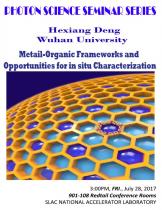Speaker: Hexiang Deng, Wuhan University
Program Description
Metal-Organic Frameworks (MOFs) are useful due to their application potentials in gas storage, separation and catalysis. The pore aperture and pore size are two critical parameters of these porous materials because they dictate the size and capacity of the guest molecules accessing pore environments. In this talk, we will present the design, synthesis and characterization of a series of MOFs with progressively increased pore aperture, the largest close to 10nm. Their pores precisely controlled to selectively include biomolecules such as proteins and DNAs. The behavior of guest molecules inside the MOF pores and their interactions are revealed by in situ X-ray techniques as an example for many other potential in situ characterization methods.





